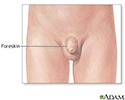Circumcision
Foreskin removal; Removal of foreskin; Newborn care - circumcision; Neonatal care - circumcisionCircumcision is the surgical removal of the foreskin of the penis.
-
Description
The health care provider will most often numb the penis with local anesthesia before the procedure starts. The numbing medicine may be injected at the base of the penis, in the shaft, or applied as a cream.
There are several ways to perform a circumcision. Most commonly, the foreskin is pushed from the head of the penis and clamped with a metal or plastic ring-like device.
If the ring is metal, the foreskin is cut off and the metal device is removed. The wound heals in 5 to 7 days.
If the ring is plastic, a piece of suture is tied tightly around the foreskin. This pushes the tissue into a groove in the plastic over the head of the penis. Within 5 to 7 days, the plastic covering the penis falls free, leaving a completely healed circumcision.
The baby may be given a sweetened pacifier during the procedure. Tylenol (acetaminophen) may be given afterward.
In older and adolescent boys, circumcision is most often done under general anesthesia so the boy is asleep and pain free. The foreskin is removed and stitched onto the remaining skin of the penis. Stitches that dissolve are used to close the wound. They will be absorbed by the body within 7 to 10 days. The wound may take up to 3 weeks to heal.
##RemoveMe##
-
Why the Procedure Is Performed
Circumcision is often performed in healthy boys for cultural or religious reasons. In the United States, a newborn boy is often circumcised before he leaves the hospital. Jewish boys, however, are circumcised when they are 8 days old.
In other parts of the world, including Europe, Asia, and South and Central America, circumcision is rare in the general population.
The merits of circumcision have been debated. Opinions about the need for circumcision in healthy boys vary among providers. Some believe there is great value to having an intact foreskin, such as allowing for a more natural sexual response during adulthood.
In 2012 a task force of the American Academy of Pediatrics reviewed current research and found that the health benefits of newborn male circumcision outweigh the risks. They recommended that there should be access to this procedure for those families that choose it. Families should weigh the health benefits and risks in light of their own personal and cultural preferences. The medical benefits alone may not outweigh those other considerations.
##RemoveMe##
-
Risks
Risks related to circumcision:
- Bleeding
- Infection
- Redness around the surgery site
- Injury to the penis
Some research has suggested that uncircumcised male infants have an increased risk of certain conditions, including:
- Cancer of the penis
- Certain sexually transmitted diseases, including HIV
- Infections of the penis
- Phimosis (tightness of the foreskin that prevents it from retracting)
- Urinary tract infections
The overall increased risk for these conditions is thought to be relatively small.
Proper hygiene of the penis and safe sexual practices can help prevent many of these conditions. Proper hygiene is especially important for uncircumcised males.
##RemoveMe##
-
After the Procedure
For newborns:
- Healing time is about 1 week.
- Place petroleum jelly (Vaseline) onto the area after changing the diaper. This helps protect the healing area.
- Some swelling and yellow crust formation around the site is normal.
For older children and adolescents:
- Healing may take up to 3 weeks.
- In most cases, the child will be released from the hospital on the day of the surgery.
- At home, children should avoid vigorous exercise while the wound heals.
- If bleeding occurs during the first 24 hours after surgery, use a clean cloth to apply pressure to the wound for 10 minutes.
- Place an ice pack on the area (20 minutes on, 20 minutes off) for the first 24 hours after surgery. This helps reduce swelling and pain.
Bathing or showering is allowed most of the time. The surgical cut may be gently washed with mild, unscented soap.
Change the dressing at least once a day and apply an antibiotic ointment. If the dressing gets wet, change it promptly.
Use prescribed pain medicine as directed. Pain medicines should not be needed longer than 4 to 7 days. In infants, use only acetaminophen (Tylenol), if needed.
Call your provider if:
- New bleeding occurs
- Pus drains from the area of the surgical cut
- Pain becomes severe or lasts for longer than expected
- The entire penis looks red and swollen
##RemoveMe##
-
Outlook (Prognosis)
Circumcision is considered a very safe procedure for both newborns and older children.
##RemoveMe##
References
American Academy of Pediatrics Task Force on Circumcision. Male circumcision. Pediatrics. 2012;130(3):e756-785. PMID: 22926175 www.ncbi.nlm.nih.gov/pubmed/22926175.
Lao OB, Raynor SC. Circumcision. In: Holcomb GW, Murphy JP, Ostlie DJ, eds. Ashcraft's Pediatric Surgery. 6th ed. Philadelphia, PA: Elsevier Saunders; 2014:chap 60.
McCammon KA, Zuckerman JM, Jordan GH. Surgery of the penis and urethra. In: Wein AJ, Kavoussi LR, Partin AW, Peters CA, eds. Campbell-Walsh Urology. 11th ed. Philadelphia, PA: Elsevier; 2016:chap 40.




